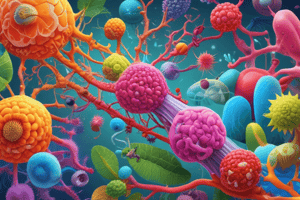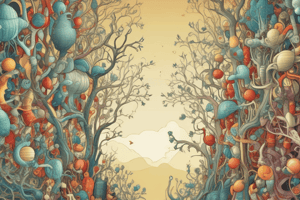Podcast
Questions and Answers
What is the primary result of cell differentiation?
What is the primary result of cell differentiation?
- Cells lose their ability to perform tasks.
- Cells become identical to each other.
- Cells replicate without changing their function.
- Cells change from a generalized to a specialized form. (correct)
Which term describes a diagram that shows how a trait is inherited across generations?
Which term describes a diagram that shows how a trait is inherited across generations?
- Punnett square
- Karyotype
- Genogram
- Pedigree (correct)
What is the key feature that differentiates homozygous alleles from heterozygous alleles?
What is the key feature that differentiates homozygous alleles from heterozygous alleles?
- Homozygous alleles are always dominant.
- Homozygous alleles consist of two identical copies. (correct)
- Homozygous alleles are two different types.
- Heterozygous alleles produce more genetic variation.
What process is described by the breaking down of glucose to produce ATP in the presence of oxygen?
What process is described by the breaking down of glucose to produce ATP in the presence of oxygen?
Which statement accurately describes mutations?
Which statement accurately describes mutations?
What is the purpose of Punnett squares in genetics?
What is the purpose of Punnett squares in genetics?
Which statement best describes cellular respiration?
Which statement best describes cellular respiration?
How do sex-linked traits differ in their inheritance patterns between genders?
How do sex-linked traits differ in their inheritance patterns between genders?
What characterizes a control group in an experiment?
What characterizes a control group in an experiment?
In multicellular organisms, which level of organization comes first?
In multicellular organisms, which level of organization comes first?
Flashcards
What is mitosis?
What is mitosis?
The process where the nucleus of a cell divides, creating two identical nuclei. Think of it as a cell making an exact copy of itself.
What is a population?
What is a population?
A group of the same species living in a specific geographical area.
What is cell differentiation?
What is cell differentiation?
The changes in a cell that allow it to perform a specific task.
What is a control group?
What is a control group?
Signup and view all the flashcards
What is homeostasis?
What is homeostasis?
Signup and view all the flashcards
Cell Differentiation
Cell Differentiation
Signup and view all the flashcards
Cell Specialization
Cell Specialization
Signup and view all the flashcards
Punnett Square
Punnett Square
Signup and view all the flashcards
Homeostasis
Homeostasis
Signup and view all the flashcards
Population
Population
Signup and view all the flashcards
Study Notes
Biology Fundamentals
- Biology is the study of all living things.
Cellular Respiration and Processes
- Cellular Respiration (Aerobic): Breakdown of glucose to produce ATP using oxygen.
- Krebs Cycle: Pyruvic acid is metabolized.
- Mitosis: Cell nucleus divides creating two identical nuclei.
- Cell Differentiation: Generalized cells transform into specialized cells performing specific tasks.
- Cell Specialization: Cells with specific functions are created after differentiation.
- Melanin: Gives skin color and UV protection.
Reproduction and Genetics
- Sexual Reproduction: Involves genetic variation.
- Punnett Squares: Used to predict possible offspring genotypes.
- Homozygous: Two identical alleles present in an organism.
- Heterozygous: Two different alleles present in an organism.
- Pedigree: Diagram showing trait inheritance through relations.
- Sex-Linked Traits: More common in males than females.
- Mutations: Changes in genetic material.
- Sickle Cell Disease: Occurs when the SS allele is present.
- Genetic Variation: Differences in genes among individuals.
- Population: Group of the same species living in a common area.
Experimental Design and Biological Systems
- Control Group: Includes the independent and dependent variables; The variable is not changed.
- Experimental Group: The variable is changed.
- Independent Variable: Measured throughout the experiment.
- Dependent Variable: Manipulated variable in the experiment.
- Homeostasis: Essential for living things to function properly.
- Multicellular Organization: Cells → Tissues → Organs → Organ Systems.
Studying That Suits You
Use AI to generate personalized quizzes and flashcards to suit your learning preferences.





